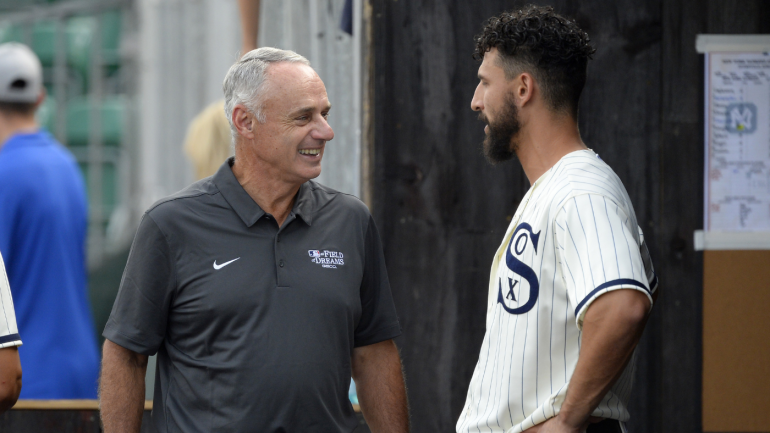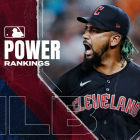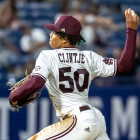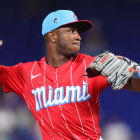
The MLB Players Association on Monday in New York City met with Major League Baseball's bargaining representatives in an effort to bring an end to the ongoing owner lockout that's brought baseball to a halt. MLB initiated the labor stoppage on Dec. 2 upon expiration of the collective bargaining agreement (CBA), which is the binding accord that governs almost every aspect of the player-team working relationship. As expected, the union at this meeting presented a counterproposal to what owners offered up on Jan. 13.
Via the reporting of The Athletic's Evan Drellich, here are the three key takeaways from the players' latest proposed framework for a new CBA:
- Most critically, Drellich reports that the players are no longer asking for free agency to be tied to a player's age rather than (or in addition to) his amount of MLB service time. Presently, players are eligible for free agency only after six full years of MLB service time.
- The union also revised prior proposals regarding revenue sharing among MLB clubs.
- Players are still proposing to reduce the timeline for arbitration eligibility from three years to two years.
The ideas the players are now advancing are in contrast with what the owners most recently proposed on Jan. 13, which, according to Drellich, players rejected -- perhaps wholly rejected -- during Monday's talks:
- Raising the minimum salary and making more money available to Super Two players, a subset of players who quality for arbitration four times rather than the usual three based on their service time. (per MLB Network's Jon Heyman).
- Draft pick bonuses for teams that do not manipulate the service time of top prospects. (per Sportsnet's Ben Nicholson-Smith)
- Adjustments to the league's previously proposed draft lottery. (per ESPN's Jeff Passan)
All of these ideas flow to some extent from what both sides put forward prior to the owner lockout:
| MLB PROPOSED | MLBPA PROPOSED |
|---|---|
Gradually raising the luxury-tax threshold to $220 million by 2026 | Raising the luxury-tax threshold to $245 million |
Pay-for-play arbitration system and free agency for all at age 29.5 | Free agency at five years of service time and age 29.5, or six years of service time, whichever comes first |
Eliminating draft pick compensation for free agents | Service-time bonuses for All-Star Game selections, awards, etc. |
Expanded 14-team postseason | Expanded 12-team postseason |
Draft lottery for top three picks | Draft lottery with a market size component |
Monday's discussions also yielded two potential causes for at least soft optimism that there's some momentum toward a deal:
Progress: The last time MLB and the players association met face-to-face in Texas the meeting lasted 7 minutes.
— Bob Nightengale (@BNightengale) January 24, 2022
Today’s session was about two hours and included significant proposals
And:
MLB and the Players Association will meet again tomorrow. The pace has officially picked up.
— Hannah Keyser (@HannahRKeyser) January 24, 2022
On a substantive level, all of these proposals and discussions have centered around what has become known as the suite of "core economic issues" facing baseball. Given that the average player salary has declined in the face of ever-soaring franchise values, the union wants to alter the economic structure of the game by getting young players paid more and paid sooner. Those young players have become a stronger presence in the contemporary game in large measure because they're so grossly underpaid in their pre-arbitration and pre-free agency years, thus their appeal to team owners.
From the union standpoint, the clearest path to address that imbalance would be one toward a significant increase to the minimum salary while at the same time angling to lower the bar for arbitration eligibility back to two years (where it was during the early existence of the process). As well, discussions have taken place on how to address the "tanking" phenomenon among teams and the status of the luxury tax on payrolls moving forward -- i.e., whether the tax threshold will be raised and by how much. As for the revenue sharing issue, it's a source of concern because the transfer of such a large percentage of local revenues from large-market teams to small-market clubs has in essence guaranteed the latter profitability regardless of what kind of team they put on the field. From the union standpoint, this is the heart of the revenue-sharing matter:
If you're curious about the relationship between CBA terms and player salaries in MLB, here's a graph of player's share of revenue by CBA from 1990-2015. Clearly, something changed in 2003. pic.twitter.com/rkGYFfAqWC
— J.C. Bradbury (@jc_bradbury) November 30, 2021
What happened in 2003? Revenue sharing increased greatly. If you're sharing more revenue, winning is less important to your bottom line, so you have less incentive to bid for players. Here's a summary table of some of the key provisions. pic.twitter.com/vK8z8nnaY1
— J.C. Bradbury (@jc_bradbury) November 30, 2021
In broad terms, owners are of course largely content with the status quo, which explains why they've shown little willingness to address those core matters.
That Jan. 13 meeting mentioned above was the first face-to-face meeting between the two sides since the lockout began on Dec. 2 – a delay owing to the owners' slow negotiating pace. Commissioner Rob Manfred in his open letter explaining the rationale for the owner-imposed work stoppage wrote, "We hope that the lockout will jumpstart the negotiations and get us to an agreement that will allow the season to start on time." Then, however, the owners took 43 days to put forward their first post-lockout proposal. This relatively quick response by the players accelerates that pace, but now that it's the owners' turn once again they may likewise stall once again.
Whatever the near future holds, the clock continues to tick, as spring training games are on the docket for Feb. 26. As our Mike Axisa recently wrote, de facto deadlines for a normal 2022 spring training and regular season are fast approaching.


















